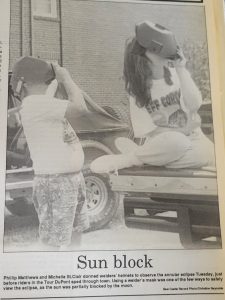
Peggy Walton
From the February 1994 edition of The New Castle Record
The record-breaking cold temperatures, ice and snow storms slowing down people’s pace over the past month have left some wildlife in the Jefferson National Forest frozen stiff, while driving many Craig County folks stir-crazy from getting iced into their homes for weeks on end.
Parents and kids have had to deal with almost a month’s vacation from school. The extended break from school has made it hard for parents to entertain their frustrated children, especially since there were many days when it was far too cold to go outside and play. Unfortunately, the children will pay for their freedom from the schoolhouse with loss of the majority of spring break.
Temperatures well below zero made it hard on fire fighters last week, as one cabin near Craig Creek burned down almost as soon as help arrived. Members of the New Castle Volunteer Fire Department were hindered by the need to fight both fire and ice.
“It’s hard on the equipment, it’s hard on the people, and it’s also the time of year when most fires occur.” Said volunteer fire fighter Woody Lipps. “You’ve gotta be extra careful.”
Lipps, a law enforcement officer for the New Castle Ranger District of the JNF, said the freeze has also taken its toll of the forest. One man greeted by a morbid memento while walking through the forest last week—a hawk lay dead on the ground, frozen solid. Lipps said the hawk was in perfect shape, without any cut or signs of injury. The bird just turned into what he described as a “hawksickle.”
The ice and snow has had some positive effects on the forest, however. District Ranger Bob Boardwine said the Southern Pine Beetle and other insects which wreak havoc on the forest have been seriously threatened by the extreme cold.
“The hope is that it’s killed enough of them to knock their population down this summer,” Boardwine said.
The forest may seem more pleasant to some when it warms up a bit, as gnats, mosquitos and other pests should decrease in number as well.
“This kind of weather’s hard on wildlife,” the ranger said. “I don’t see how they make it.”
Deer can get frostbite, even through their hooves. And it is difficult for them to find vegetation to eat, since they cannot dig through the ice and crusty snow to reach food. Tracks have shown that deer are relying on tree seedlings which sprout through the snow.
“That’s all they can get to,” said Broardwine.
-Prepared by Shelly Koon



